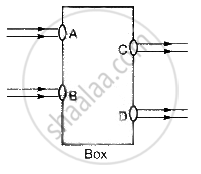Advertisements
Advertisements
प्रश्न
A student has to determine the focal length of a concave mirror by obtaining the image of a distant object on a screen. For getting best result he should focus
(A) a distant tree or an electric pole
(B) a well-illuminated distant building
(C) well-lit grills of the nearest window
(D) a burning candle laced at the distant edge of the laboratory table
उत्तर
In order to determine the focal length of a concave mirror, the student should focus on a distant tree or an electric pole.
The Correct Answer is A
APPEARS IN
संबंधित प्रश्न
Draw a ray diagram to show the path of the refracted ray in each of the following cases:-
A ray of light incident on a concave lens is
(i) passing through its optical centre.
(ii) parallel to its principal axis.
(iii) directed towards its principal focus.
List four specific characteristics of the images of the objects formed by convex mirrors.
Draw a ray diagram to show the path of the reflected ray corresponding to an incident ray of light parallel to the principal axis of a concave mirror. Mark the angle of incidence and angle of reflection on it.
A concave mirror produces three times magnified (enlarged) real image of object placed at 10 cm in front of it. Where is the image located?
The image formed by a concave mirror is observed to be virtual, erect and larger than the object. Where should be the position of the object?
What is the minimum number of rays required for locating the image formed by a concave mirror for an object? Draw a ray diagram to show the formation of a virtual image by a concave mirror.
Make labelled ray diagrams to illustrate the formation of:
a real image by a converging mirror.
Beams of light are incident through the holes A and B and emerge out of box through the holes C and D respectively as shown in the figure. Which of the following could be inside the box?

For a real object, which of the following can produce a real image?
Which type of mirror is used in the following?
Shaving mirror
